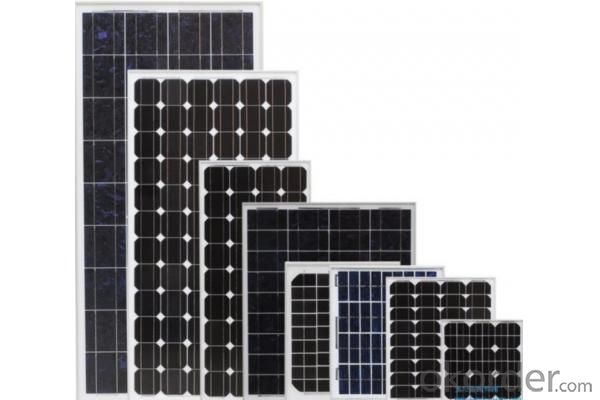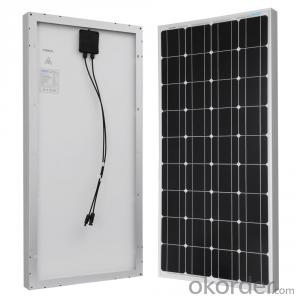100w Poly Solar Module With High Efficiency
- Loading Port:
- Tianjin
- Payment Terms:
- TT OR LC
- Min Order Qty:
- 1 watt
- Supply Capability:
- 100000 watt/month
OKorder Service Pledge
OKorder Financial Service
You Might Also Like
Item specifice
Product Description:
1.Structure of Solar Module Description
CNBM Solar's photovoltaic module is designed for designed for large electrical power requirement. It is the optimal choice for both on-grid and off-grid power systems. CNBM Solar offers high performance of power per square foot of solar array.
2.Main Features of the Solar Module
Solar Cell: High efficency crystalline solar cell. Even if under the weak light, the solar module can produce maximum power output.
Tempered glass: Anti-reflecting coating and high transmission rate glass increase the power output and mechanical strength of solar module.
EVA and TPT: Using high quality EVA and TPT to prevent destroying and water.
Strong aluminum frames to strengthen the load hold and to stand against high wind.
Junction box: Multi function junction box with water proof.
Long lifetime: ≥25 years; Less power decrease.
Good performance of preventing from atrocious weather such as wind and hails.
Resisting moisture and etching effectively, not effected by geology.
The certificate issued by international authority: UL, TUV, IEC, VDE, CE.

Solar panel working process
In addition to being the ultimate source of all life on earth, the sun is an infinitely renewable, completely pollution-free source of electricity. Instead of burning fossil fuels dug up from the ground in a big power plant – a very 19th century, industrial age approach, when you think about it – solar panels convert sunlight directly into electricity, with no harmful emissions.
The basic unit of a solar panel is a solar cell, which usually consists of one or two layers of silicon-based semiconductor wafers. When struck by the photons in sunlight, the solar cell generates an electrical charge due to the "photovoltaic effect" – which is a pretty good name, since it produces voltage from photons. The flow of these electrons moves in a steady electrical current from one side of the cell to the other.
Dozens of these PV cells are packaged together into solar modules, which in turn are packaged into solar panels that are mounted on a rooftop and arranged to maximize their hours of exposure to direct sunlight. Because the electricity generated by all those solar cells is direct current (DC), it is then sent to an inverter that transforms the power into the same alternating current (AC) used by the appliances in your home and the local utility electricity distribution grid. Increasingly, these inverters are getting "smart," providing data monitoring for solar installation performance and other grid integration services.
- Q:I can't figure out how to charge a Ni Cd (BD 8V Firestorm) battery directly with a solar panel so I've come up with an alternative which might or might not work. I thought I would connect an inverter (I found a nice 400W for $30) to my trucks battery and plug the BD Firestorm battery charger into the inverter. Then I was thinking I could use a 5W solar panel to trickle charge the truck battery and keep it connected after the Ni Cd is charged to ensure the truck battery is topped off. The truck would not be running during this process. Will this solution work? Is there a better solution?
- image voltaic charger employs image voltaic ability to offer electricity to units or cost batteries. they're oftentimes portable. image voltaic array: electric powered gadget alongside with an excellent array of related image voltaic cells image voltaic Panel is a crew of image voltaic cells arranged right into a panel which would be put in onto a flat floor. The panel captures image voltaic and converts it into DC ability.
- Q:I need to write a pressuasive essay on why we should use solar panels more than we do. and convince people that their good and stuff.. if u guys could give me some good key reasons why..that would be great.
- if they get energy from burning coal, they will be destroying our atmosphere. if they use solar panels, they can use natural energy from the sun without harming the environment.
- Q:Can solar panels be used to power air conditioning units?
- Yes, solar panels can be used to power air conditioning units. Solar panels generate electricity from sunlight, which can be used to power various appliances, including air conditioning units. This is an eco-friendly and cost-effective way to cool buildings and reduce reliance on traditional energy sources.
- Q:What is the impact of hailstorms on solar panels?
- Hailstorms can have a significant impact on solar panels. The impact of hailstones hitting the panels can cause physical damage, such as cracks or shattered glass, which can impair the panel's ability to generate electricity. This damage not only affects the efficiency of the solar panels but also necessitates costly repairs or replacements. Therefore, hailstorms pose a considerable risk to the overall performance and longevity of solar panels.
- Q:How do solar panels affect the property's overall cost savings?
- Solar panels can significantly impact a property's overall cost savings by reducing or eliminating electricity bills. With the ability to generate clean and renewable energy, solar panels offset the need for traditional grid electricity, resulting in long-term savings. Additionally, solar panels can increase property value and attract potential buyers or tenants, further enhancing cost savings over time.
- Q:I want to buy a solar panel to charge deep cycle batteries and charge electronics off the DCB. I don't know how to wire everything up though or what materials ill need. Inverter? Gauge of the wire? Ampmeter?
- the solar panel should state it, you dont need a inverter to charge, only to use the power from the cell.you do need an amp regulator, so it tells if the battery is on full charge and so the sun doesnt over power the battery through the solar panel
- Q:If I wanted to put some solar panels on my roof, how many would i need and how many watts would they have to be to be able to power my whole house?
- Actually even if you cover your whole roof with panels, you wont get enugh power to even run a tv, fan and light at the same time. Solar panels give out a very less power output.
- Q:How much energy can a solar panel generate?
- The amount of energy a solar panel can generate depends on various factors such as its size, efficiency, location, and weather conditions. On average, a standard solar panel can generate between 250 to 400 watts of electricity per hour under ideal conditions. However, it's important to note that energy production may vary throughout the day and across different seasons.
- Q:Can someone explain to me how solar panels can be used as modern architectural attributes? please help
- You could check out building integrated photovoltaics (BIPV). BIPV includes things like solar roof tiles and smart energy glass that acts as a window and also creates electricity. BIPV is a great way for people to go solar without disrupting the modern architectural attributes of an existing structure.
- Q:My husband is interested in buying solar panels for the roof and i dont know where to find them.
- The price of solar systems have dropped dramatically in the last 5 years. I would say it has reached to the point that it financially makes sense to go solar! An average home in [California] with $200 monthly electric bill would need a 7.25 kW system to offset 00% of their electric bill (means you won't have to pay anything to your utility company). Average price of the panels are anything between $2,500-3,500 per kW (after 30% Federal Tax credit which might expire at the end of 206). So, average system price will be $7,000-$25,000. If you wanna buy the system your loans monthly payments will be around $40-50 for 2 years and after that your system is paid off and you can enjoy free electricity! Total saving over 25 years can exceed $70,000. Regarding the selection of the right panels or the best company in your area, it varies case by case, city by city. Pick My Solar offers a free service to homeowners to choose the right fit for their home. It's like Expedia or Priceline for residential solar market.
1. Manufacturer Overview |
|
|---|---|
| Location | |
| Year Established | |
| Annual Output Value | |
| Main Markets | |
| Company Certifications | |
2. Manufacturer Certificates |
|
|---|---|
| a) Certification Name | |
| Range | |
| Reference | |
| Validity Period | |
3. Manufacturer Capability |
|
|---|---|
| a)Trade Capacity | |
| Nearest Port | |
| Export Percentage | |
| No.of Employees in Trade Department | |
| Language Spoken: | |
| b)Factory Information | |
| Factory Size: | |
| No. of Production Lines | |
| Contract Manufacturing | |
| Product Price Range | |
Send your message to us
100w Poly Solar Module With High Efficiency
- Loading Port:
- Tianjin
- Payment Terms:
- TT OR LC
- Min Order Qty:
- 1 watt
- Supply Capability:
- 100000 watt/month
OKorder Service Pledge
OKorder Financial Service
Similar products
New products
Hot products
Related keywords




























